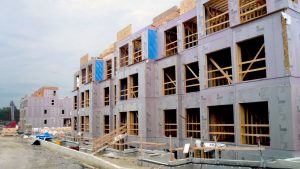Commercial real estate firm has weighed in on debate, issuing a data-laden report arguing that a complete repeal of the bylaw is the best strategy to boost housing supply and support the ailing office sector.
In the report, titled Less Office, More Housing, JLL says a repeal of the bylaw is recommended because it would make it more attractive for developers to demolish and redevelop obsolete, low-grade office buildings.
Redevelopment is favoured over office conversions, which JLL suggests will not be a significant source of new housing because they are too heavily funded by taxpayers and are not scalable.
JLL has found there are 73 parcels in Toronto where there is currently a redevelopment project proposed at the site of an existing office building, and removing the office-conversion burden would clear the way for construction of over 51,000 new residential units on those sites.
said his firm is uniquely placed to contribute such analysis because JLL collects data on both the office and residential markets in the city. He said the issue is impactful and critical for Toronto and requires immediate solutions.
‘This is a structural problem’

“We feel like we’re in this critical moment that we’re experiencing right now, in terms of the housing crisis,” said Figler. “Real estate markets go through cycles, but this is something that isn’t cyclical, this is a structural problem.”
“It’s our belief that the city needs to really unturn every stone to find solutions. And I’m going to make a bold statement here, I think when it comes to the housing market, this is the most impactful policy tool that the municipal government has at its disposal.”
Toronto’s Office Replacement Bylaws, requiring developers to replace office footage they plan to eliminate as part of redevelopment jobs, were intended to ensure Toronto could offer adequate workspace capacity, the report explains.
They generally apply to specific nodes, including the financial district, Bloor-Bay, Yonge-Eglinton and the health sciences district. But given the current oversupply of office space and the “rising risk of functional obsolescence in many lower-grade office buildings,” JLL says, city council is exploring whether to repeal the bylaw and make it easier for landlords and developers to redevelop properties into their best use.
Repealing the bylaw is one of several options under consideration, along with lowering the threshold for replacement, offering exemptions or offering incentives to create affordable housing, among other measures.
Office vacancy has risen consistently throughout the GTA since 2020, from 6.4 per cent just before the pandemic to 18.1 per cent today. But even before the pandemic, data showed the office utilization rate — space usage per each employee — was in decline for technological and other reasons.
The latest Labour Force Survey from Statistics Canada estimates about one-fourth of Toronto workers are working from home at least four days per week. JLL noted industries that are main contributors to office demand in Toronto, such as finance, life sciences, tech and insurance, have lower levels of office utilization.
Meanwhile, as of August 2024, housing starts were down almost 20 per cent from the 2023 pace.
That will translate into a slowdown in completions beyond 2026.
Figler said the Office Replacement Bylaws don’t fit the modern world.
“First and foremost, the city needs to take care of the low-hanging fruit,” he said. “This is the low-hanging fruit. It’s not a taxpayer-funded subsidy. It’s not the city trying to develop 50,000 units. All they have to do is remove a zoning law.”
JLL calculates that removal of the bylaws could eliminate over nine million square feet of lower grade office space from the Toronto market, reducing overall office vacancy by three to four per cent and hiking valuation of the remaining properties.
Office-to-residential conversions will continue as a minor policy tool, JLL said, with about five per cent of buildings structurally feasible for the conversions. Calgary’s touted conversion success comes with high subsidies from taxpayers, Figler noted.
Forcing developers to replace office space as part of redevelopment projects means no-go’s for many proposals, Figler said.
“Out of multiple factors that developers are considering when they green-light or don’t green-light a project, the city needs to be focused on doing whatever they can to get developers to green-light projects.”
Follow the author on X/Twitter @DonWall_DCN.









Recent Comments